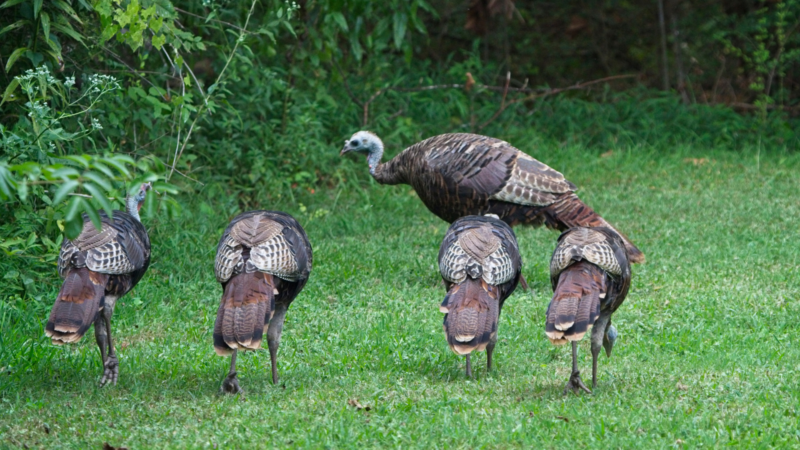Seeing wild turkeys parade through neighborhoods and backyards is entertaining. The answers to these questions, however, may surprise you given what you’ve heard. Can wild turkeys fly? If so, how quickly?
While both domesticated and wild turkeys are the same species, their differences are vast, ranging from physical capabilities to historical origins. Here’s a breakdown of the key distinctions:
Physical Capabilities:
- Flight: Domestic turkeys have lost their ability to fly due to selective breeding for heavier, broad-breasted birds. Wild turkeys, however, can fly distances of over a mile at speeds of 55 miles per hour.
- Speed: While domestic turkeys are limited by their shorter legs, wild turkeys are slim, tall, and long-legged, allowing them to outrun a galloping horse for short distances.
- Senses: Wild turkeys possess keen eyesight, hearing, and native cunning, making them elusive prey for both human and animal hunters.
Historical Origins:
- Domestication: Domestication of turkeys by Native Americans predates European arrival in North America. Turkey bones have been found in Indian burial mounds, and turkeys were raised in Mexico and Central America for centuries before Spanish colonization.
- Spread: Spanish explorers brought domesticated turkeys to Europe in 1519, leading to their rapid spread and introduction to England between 1524 and 1541.
- Crossbreeding: After domestic turkeys spread across Europe, colonists brought them back to the New World, where they were crossbred with wild turkeys, resulting in the six common domestic varieties in the US.
Other Distinctions:
- Predation: Domestic turkeys lack the “wood smarts” of their wild counterparts and often fall prey to predators like bobcats, foxes, or coyotes.
- Release of pen-raised turkeys: State law prohibits the release of pen-raised turkeys to prevent disease transmission and contamination of the wild turkey gene pool.
Fun Turkey Trivia:
- North America has five wild turkey subspecies: Eastern, Osceola, Rio Grande, Merriam’s, and Gould’s.
- An adult wild turkey has about 5,500 feathers, including 18 tail feathers forming the male’s distinctive fan.
- Wild turkeys have excellent daytime vision and can see in color, with a visual field exceeding 270 degrees.
- Wild turkeys are omnivores, feeding on acorns, nuts, seeds, berries, greens, insects, small amphibians, and reptiles.
- Male turkey droppings are J-shaped, while female droppings are spiral-shaped.
- The male turkey’s head can be red, white, blue, or a combination. Its bald head and fleshy facial wattles change color with excitement.
- The flap of skin over a turkey’s bill is called a snood and changes color, size, and shape based on mood and activities.
- Adult male turkeys are called toms, females are hens, young turkeys are poults, juvenile males are jakes, and juvenile females are jennies. A group of turkeys is called a rafter or a flock.
While both domesticated and wild turkeys share the same species, their differences are significant, reflecting their distinct evolutionary paths and adaptations. Understanding these differences allows for a deeper appreciation of these fascinating birds, whether gracing our Thanksgiving tables or soaring through the skies.
Why do so many people think turkeys can’t fly?

“People consider turkeys to be ground birds because they spend so much time on the ground eating and interacting with other turkeys,” according to Erickson. Furthermore, a lot more people are familiar with farm-raised turkeys than with wild ones. Despite being members of the same species, farm turkeys have been selectively bred for many generations to have large pectoral muscles, which are responsible for powering their wings. ”.
According to Erickson, their heavier load is too great for their wings to bear. While some farm turkeys are occasionally able to fly, the majority are not
How high can turkeys fly?
You won’t witness turkeys circling the sky like hawks. At night, they do so to roost in trees, but that’s the highest altitude you’ll likely witness them reach. The treetops are pretty much the highest they will go, unless they are attempting to flee from a predator.
Large Flock of Turkeys Fly Across the Road and Over Traffic | Wild Bird Behavior
FAQ
Can turkeys fly long distance?
What is the approximate longest distance a wild turkey can fly?
Do wild turkeys fly high?
Do wild turkeys have a home range?
How far can a Turkey fly?
Their broad wings and slim neck helps them fly as far as 400 meters from the ground. They can also fly down the mountains in hilly areas or woodlands. Although wild turkeys like running more than they like flying, they can still fly; they can fly a little distance, especially at night, though they can’t go very high. Can Domestic Turkeys Fly?
How fast can a wild turkey fly?
Once airborne, a wild turkey will quickly reach its intended roosting spot, or land on the ground a safe distance from the threat that spooked it into flight. On land, wild turkeys can cover far more ground, reaching running speeds of around 40 km/h (25 mph). How high can wild turkeys fly?
Do wild turkeys fly?
Wild turkeys are better equipped for running than flight, but they can fly in short bursts of powerful flight when they need to. They are not built for graceful flight, but can fly to escape predators or find nightly roosting spots in trees.
Do wild turkeys need long-term flight capabilities?
Wild turkeys lack the necessary long-term flight capabilities to fly a sufficient distance for regular migration.
